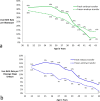A validated model for predicting live birth after embryo transfer
- PMID: 34031492
- PMCID: PMC8144418
- DOI: 10.1038/s41598-021-90254-y
A validated model for predicting live birth after embryo transfer
Abstract
Accurately predicting the probability of live birth and multiple gestations is important for determining a safe number of embryos to transfer after in vitro fertilization. We developed a model that can be fit to individual clinic data for predicting singleton, twin, and total live birth rates after human embryo transfer. The predicted and observed rates of singleton and twin deliveries were compared in a tenfold cross-validation study using data from a single clinic. The model presented accounts for patient age, embryo stage (cleavage or blastocyst), type of transfer cycle (fresh or frozen) and uterine/universal factors. The standardized errors for rates of singleton and twin deliveries were normally distributed and the mean errors were not significantly different from zero (all p > 0.05). The live birth rates per embryo varied from as high as 43% for fresh blastocysts in the 35-year-old age group to as low as 1% for frozen cleavage stage embryos in the 43-year-old age group. This quantitative model or a simplified version can be used for clinics to generate and analyze their own data to guide the number of embryos to transfer to limit the risk of multiple gestations.
Conflict of interest statement
The authors declare no competing interests.
Figures




Similar articles
-
Guidelines for the number of embryos to transfer following in vitro fertilization No. 182, September 2006.Int J Gynaecol Obstet. 2008 Aug;102(2):203-16. doi: 10.1016/j.ijgo.2008.01.007. Int J Gynaecol Obstet. 2008. PMID: 18773532 Review.
-
Cumulative live birth rates following blastocyst- versus cleavage-stage embryo transfer in the first complete cycle of IVF: a population-based retrospective cohort study.Hum Reprod. 2020 Oct 1;35(10):2365-2374. doi: 10.1093/humrep/deaa186. Hum Reprod. 2020. PMID: 32949234
-
Day after rescue ICSI: eliminating total fertilization failure after conventional IVF with high live birth rates following cryopreserved blastocyst transfer.Hum Reprod. 2023 Jul 5;38(7):1277-1283. doi: 10.1093/humrep/dead097. Hum Reprod. 2023. PMID: 37208859
-
Perinatal outcomes in singleton live births after fresh blastocyst-stage embryo transfer: a retrospective analysis of 67 147 IVF/ICSI cycles.Hum Reprod. 2019 Sep 29;34(9):1716-1725. doi: 10.1093/humrep/dez133. Hum Reprod. 2019. PMID: 31418775
-
Higher probability of live-birth in high, but not normal, responders after first frozen-embryo transfer in a freeze-only cycle strategy compared to fresh-embryo transfer: a meta-analysis.Hum Reprod. 2019 Mar 1;34(3):491-505. doi: 10.1093/humrep/dey388. Hum Reprod. 2019. PMID: 30689865
Cited by
-
Study Protocol: Evaluating the Effectiveness of Variable Embryo Transfer Compared to Endometrial Receptivity Analysis in Improving Implantation and Pregnancy Outcomes in Patients with Recurrent Implantation Failure.J Pharm Bioallied Sci. 2025 May;17(Suppl 1):S940-S943. doi: 10.4103/jpbs.jpbs_321_25. Epub 2025 Apr 21. J Pharm Bioallied Sci. 2025. PMID: 40511252 Free PMC article.
-
Comparison of ART outcome in patients with poor ovarian response according to POSEIDON criteria.Sci Rep. 2022 Oct 21;12(1):17723. doi: 10.1038/s41598-022-22859-w. Sci Rep. 2022. PMID: 36271137 Free PMC article.
-
Embryo morphology and live birth in the United States.F S Rep. 2022 Feb 23;3(2):131-137. doi: 10.1016/j.xfre.2022.02.006. eCollection 2022 Jun. F S Rep. 2022. PMID: 35789729 Free PMC article.
-
Predictive model for live birth outcomes in single euploid frozen embryo transfers: a comparative analysis of logistic regression and machine learning approaches.J Assist Reprod Genet. 2025 May 22. doi: 10.1007/s10815-025-03524-3. Online ahead of print. J Assist Reprod Genet. 2025. PMID: 40402397
References
-
- Centers for Disease Control and Prevention, American Society for Reproductive Medicine, Society for Assisted Reproductive Technology. 2016 Assisted Reproductive Technology National Summary Report. Atlanta (GA): US Dept of Health and Human Services. 5–18 (2018).
MeSH terms
LinkOut - more resources
Full Text Sources
Other Literature Sources

